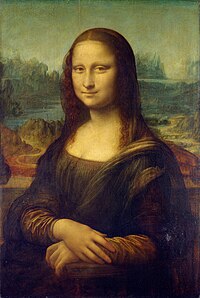The Mini Lisa is a nanoscale replica of the Mona Lisa. It was created in 2013 by Keith Carroll, a Georgia Institute of Technology PhD candidate, in order to demonstrate a technique called thermochemical nanolithography (TCNL) that was invented at the university. In TCNL, a tiny cantilever viewed through an atomic force microscope uses heat to activate a series of chemical reactions that create new molecules. Greater amounts of heat create more molecules which lighten the surface of the substrate, allowing a grayscale image to be created.[1]
The Mini Lisa is just 30 micrometres (0.0012 in) wide, about a third the width of a human hair.[1] It is roughly 1/25,000th the size of the Mona Lisa. The Mini Lisa was created by making hundreds of individual points each 125 nanometres (4.9×10−6 in) wide.[1] Carroll decided to recreate the Mona Lisa after a challenger claimed TCNL was not precise enough to create a work of art.[2] He created an automated process to create any image desired based on a supplied heat map.[3]
The Mini Lisa project, which also included recreations of photographs by Ansel Adams, was published in Langmuir in August 2013.[2] The paper's lead author, physicist Jennifer Curtis, said the experiment demonstrated for the first time that it was possible not only to manipulate molecules on a nano-scale, but also precisely control how many are there. She said that TCNL "should enable a wide range of previously inaccessible experiments" in a diverse set of fields as it evolves.[1][3] The project also received mention in the popular press.[1]
- ^ a b c d e Eoin O'Carroll (August 7, 2013). "'Mini Lisa': Georgia Tech researchers create world's tiniest da Vinci reproduction". Christian Science Monitor. Retrieved August 8, 2013.
- ^ a b Nick Clark (August 7, 2013). "Small is beautiful: The molecular art that's made a mini-masterpiece of the Mona Lisa". The Independent. Archived from the original on 2022-05-15. Retrieved August 8, 2013.
- ^ a b Deborah Netburn (August 6, 2013). "Microscopic Mona Lisa reproduction, created on a bet". Los Angeles Times. Retrieved August 8, 2013.

